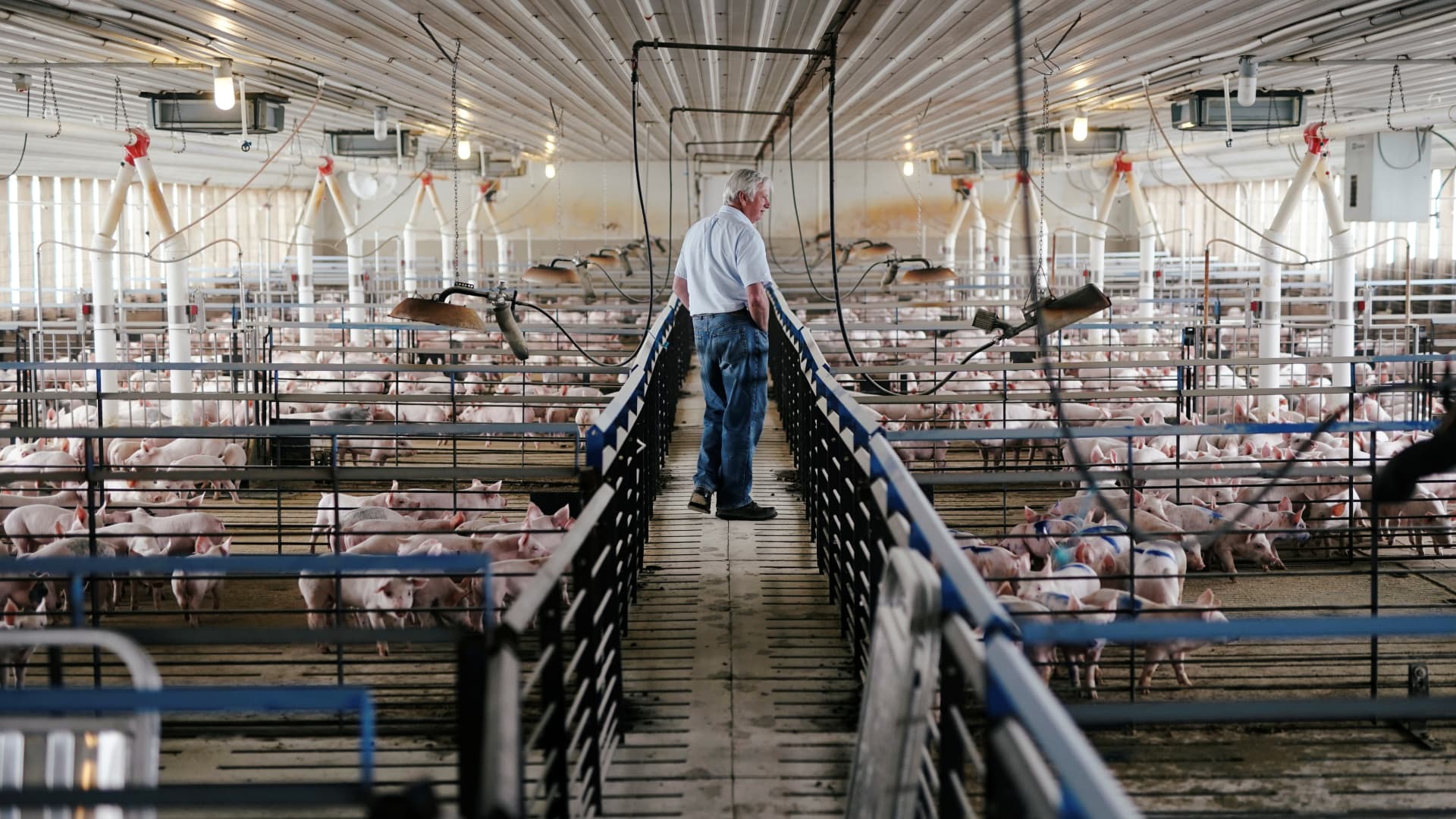Farmer Ken Ries looks out over his hogs during a tour of his hog farm in Ryan, Iowa.
Ben Brewer | Reuters
More than a third of the heat-trapping gases cooking the planet come from growing and raising farm animals, but millions of cattle, pigs and other animals get to stay cool in the United States and other parts of the developed world.
Many American farmers have apps to forecast animal comfort in the heat. There are computer-controlled “cooling pads” for sows. Dairy farmers lower barns’ temperatures with misters, air conditioning and giant fans. Special pedometers, the cow version of a Fitbit, measure vital signs that give clues to animals’ health.
More intense summer heat resulting from emissions-driven climate change means animal heat stress that can result in billions of dollars in lost revenue for farmers and ranchers if not properly managed. But technology often insulates livestock in richer countries — another way global warming exacerbates the gap between wealthy and poor nations.
The U.S. is the world’s largest producer and consumer of beef by volume. People have been drinking less milk in the U.S. but eating more cheese, and government programs still support dairies across the country. About 20% of all global greenhouse gas emissions come from animal-based food products, said Atul Jain, a professor in the department of atmospheric sciences at The University of Illinois Urbana-Champaign who studies the interactions between climate and human activities like agriculture.
Livestock producers in other parts of the world can’t adopt measures to beat the heat as easily as farmers in the U.S. A 2022 study in the Lancet Planetary Health found that cattle heat stress losses will be far greater in most tropical regions than in temperate regions, due to higher climate impacts and the relatively higher price of measures to adapt to climate change.
A farm hand milks dairy cows at a dairy farm in Crestwood, Kentucky, U.S., on Monday, Sept. 27, 2021.
Luke Sharett | Bloomberg | Getty Images
Many experts advocate for people in countries like the U.S., where diets are heavy with animal products, to eat less meat and dairy. But big, industrial farms in developed countries are relatively efficient, so to meet global demand with fewer animals, less-developed countries will also need to access the kind of technology that can make them more productive in the face of extreme heat.
“Those innovations bring me a lot of hope,” said Mario Herrero, a professor of food systems and global change at Cornell University who coauthored the Lancet Planetary Health study. “It’s a matter of how do we deploy them.”
This winter, the McAllister family of New Vienna, Iowa, installed new fans above the beds where their cows lie, and they’re happy with the updates. Their cows are already showing signs of improved welfare, like chewing more cud, and there’s more heat ahead this summer.
“We’re going to do what’s best by our cows no matter what is or isn’t going on with climate change,” said Megan McAllister, a sixth-generation dairy farmer. Her husband’s family has been farming for five generations.
September feels like another August these days, McAllister said.
“We want to make the right investments to better our cows, better our businesses that are our dairies, and make sure we’re here for the long haul and that we are thinking about sustainability,” she said.
Making that investment, of course, has a price: more fans for cooling means higher energy bills. That’s something Dr. Michelle Schack, a dairy veterinarian based in Arizona, has noticed as well. She said that the farmers she works with are well-prepared for the blistering heat the state has seen this year, because as research on animal health has improved, they’ve invested in infrastructure.
But it costs a lot.
“Fans and misters, let’s not forget, are hugely expensive, not only to install but the amount of electricity they take is insane,” Schack said.
That could be partly addressed with cheaper solar power integrated into agricultural projects. But regardless, “it’s going to be a challenge, a financial challenge” for more farms to adopt heat mitigation strategies, said Gerald Nelson, a professor emeritus at the University of Illinois Urbana-Champaign and a coauthor on the Lancet Planetary Health study.
Nelson described how different, heat-tolerant animal species or even something as simple as shade structures and extra water supplies can make a big difference when adapting to heat.
Information can help too. A team of USDA and university scientists recently launched a new app called HotHog that uses local weather data to help farmers anticipate conditions that might be uncomfortable for their pigs. And Chip Redmond, a meteorologist at Kansas State University, helped develop a seven-day animal comfort forecast tool for beef farmers that takes into account temperature as well as factors like humidity and wind.
As part of his work with Kansas State, Redmond gives presentations to producers and the general public, and he said that climate change has come up in conversations.
Both he and Jackie Boerman, an associate professor in the department of animal sciences at Purdue University, said that they recognize that farmers have to deal with the effects of climate change every day.
“We want to cool cows, but we also have to recognize that we want to also be environmentally sustainable,” Boerman said. Those two ideas are, she said, “sometimes a little bit at odds with each other.”


















![Ep264: [Lean Series] What Happens If You Diet Too Soon Ep264: [Lean Series] What Happens If You Diet Too Soon](https://carrotsncake.com/wp-content/uploads/2022/11/What-to-eat-to-balance-your-hormones-768x509.jpg)


Discussion about this post